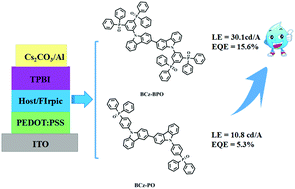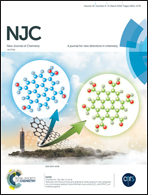High efficiency solution-processed blue electrophosphorescent device with a bipolar host material based on diphenylphosphine oxide unit
Abstract
A new bipolar material, (9H,9′H-[3,3′-bicarbazole]-9,9′-diylbis(benzene-5,1,3-triyl))tetrakis(diphenylphosphine oxide) (BCz-BPO), featuring 3,3′-bicarbazole and diphenylphosphine oxide groups has been designed and synthesized. BCz-BPO with a twisty and rigid configuration exhibited a high triplet energy, excellent thermal stability and bipolar charge carrier transport ability. Both DFT simulation and experimental results demonstrated that the increased electron-transporting ability endows the solution-processed devices based on BCz-BPO with a more balanced charge flux and a higher exciton recombination efficiency. As a result, the blue solution-processed electrophosphorescent device using BCz-BPO as the host showed a maximum luminance efficiency of 30.1 cd A−1, which was comparable to that of a (9H,9′H-[3,3′-bicarbazole]-9,9′-diylbis(4,1-phenylene))bis(diphenylphosphine oxide) (BCz-PO) based vacuum deposited device and was about three times higher when compared with that of the corresponding device based on BCz-PO. Our research put forward a guideline for the molecular design of bipolar host materials used in solution-processed PhOLEDs.



 Please wait while we load your content...
Please wait while we load your content...